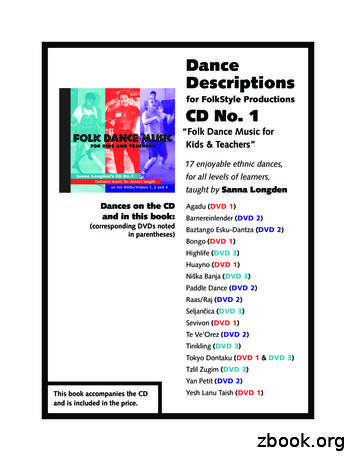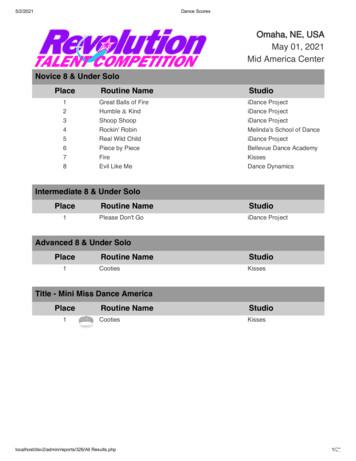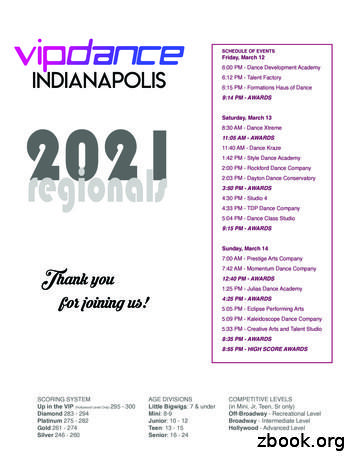Dance GCSE Subject Cv5 2 - GOV.UK
DanceGCSE subject contentJanuary 2015
ContentsThe content for dance GCSEs3Introduction3Subject aims and learning outcomes3Subject content4Performing:4Choreography:5Appreciation:62
The content for dance GCSEsIntroduction1.The GCSE subject content sets out the knowledge, understanding and skillscommon to all GCSE specifications in a given subject. Together with the assessmentobjectives it provides the framework within which awarding organisations create the detailof their specifications, so ensuring progression from key stage 3 national curriculumrequirements and the possibilities for development into A level.Subject aims and learning outcomes2.Through the study of GCSE dance students learn to choreograph, perform andappreciate dance as an art form. This holistic engagement with dance informs theirdevelopment as creative and artistic individuals, and broadens their aesthetic, social andcultural experience.3.GCSE specifications in dance must enable students to engage as choreographersthrough the: creative and imaginative response to a range of stimuli use of imagination, problem solving, creativity and the synthesis of ideas application of knowledge, skills and understanding of choreographic forms anddevices communication of ideas, feelings, emotions, meanings and moods4.GCSE specifications in dance must enable students to engage as performersthrough the: application of knowledge, skills and understanding of performing development of physical, technical, mental and expressive skills communication of choreographic intention and artistry5.the:GCSE specifications in dance must enable students to appreciate dance through articulation of knowledge and critical reflection to inform artistic practice critical appreciation of dance in its physical, artistic, aesthetic and cultural contexts3
6.critical analysis, interpretation, evaluation, and appreciation of professional danceworksGCSE specifications in dance must enable students to: participate in and appreciate dance from more than one style critically appreciate at least two professional works by at least two choreographers work collaboratively with others develop knowledge, skills and understanding of health, well-being and safe andprofessional practice relevant to dance improve own work through analysis, critical self-reflection and evaluation7.GCSE specifications in dance must reflect the learning outcomes in the content.Subject content8.This document sets out the minimum range of content for GCSE specifications indance. Awarding organisations may, however, increase depth, breadth or context ofstudy.Performing:9.Have knowledge and understanding of: physical skills and attributes including actions, posture, alignment, balance,coordination, control, flexibility, mobility, strength, stamina, extension, isolation technical skills including accuracy of action, timing, dynamic, rhythmic andspatial content, the reproduction of movement in a stylistically accurate way,physical relationship to other dancers mental skills and attributes including commitment, concentration, confidence,movement memory, systematic repetition, mental rehearsal, rehearsal discipline,planning of rehearsal, response to feedback, capacity to improve expressive skills including projection, use of focus, spatial awareness, musicality,phrasing, facial expression, interpretation and communication of mood and/ormeaning and/or intention, sensitivity to other dancers safe working practices including safe execution, appropriate dancewear,effective warming up and cooling down, nutrition and hydration4
10.Through the application of knowledge, skills and understanding demonstrate theability to: communicate artistic/choreographic intention use appropriate physical, technical and expressive skills demonstrate safe working practices perform one or more dances which requires an appropriate level of sophistication,complexity and challengeChoreography:11.Have knowledge and understanding of: the elements of dance: action, dynamics, space, relationships choreographic processes: including research, improvisation, selection,development, structuring, refining choreographic devices: including motif and development, repetition, contrast,transitions, highlights, climax, manipulation of number, unison, canon structuring devices: including binary, ternary, rondo, narrative, episodic dance for different performance environments: including proscenium/end stage,site-sensitive, in-the-round, dance for camera different stimuli and aural settings and their effect on choreographic outcomes12.Through the application of knowledge, skills and understanding demonstrate theability to: respond creatively to a stimulus or stimuli refine and synthesise ideas generate, select, develop and structure movement material select and use appropriate aural settings communicate choreographic intention be wholly responsible for the creation of a complete dance which includesmovement material and an aural setting5
Appreciation:13.Have knowledge and understanding of: two or more professional works by two or more choreographers which reflectdifferent styles of dance and different approaches to choreography andproduction, and support practical learning in performance and choreography. Atleast two works should be studied in depth different dance styles through the study of professional dance works includingidentification of the defining characteristics of different dances and recognition ofsimilarities and differences between them the contributions of choreography, performance and features of production toprofessional works including staging, lighting, properties, costume, dance forcamera and aural settings the relationships between choreography, performance and features of productionincluding staging, lighting, properties, costume, dance for camera and auralsettings and the ways in which these can be used together to enhance audienceunderstanding of mood, meaning and choreographic intention the purpose or significance of different performance environments in which dancecan be created and performed including proscenium/end stage, site-sensitive,in-the-round and dance for camera14.Through the application of knowledge, skills and understanding demonstrate theability to: use appropriate dance terminology and/or subject specific language in writtencommunication appreciate different styles of dance and different approaches to choreography andproduction communicate in written contexts about the choreographic processes communicate in written contexts about performing skills critically appreciate own dances through describing, analysing, interpreting,evaluating and reflecting critically appreciate professional works through describing, analysing, interpreting,evaluating and reflecting6
Crown copyright 2015You may re-use this document/publication (not including logos) free of charge in anyformat or medium, under the terms of the Open Government Licence v3.0. Where wehave identified any third party copyright information you will need to obtain permissionfrom the copyright holders concerned.To view this ves.gsi.gov.ukAbout this publication:enquiries www.education.gov.uk/contactusdownload 702-2014Follow us on Twitter:@educationgovukLike us on Facebook:facebook.com/educationgovuk7
of their specifications, so ensuring progression from key stage 3 national curriculum requirements and the possibilities for development into A level. Subject aims and learning outcomes . 2. Through the study of GCSE dance students learn to choreograph, perform and appreciate dance as an art form. This holistic engagement with dance informs their
From the following 14 events: Big Bang Dance Classic, Desert Dance, Line Dance Showdown, Xperience, Line Dance Marathon, Fun In The Sun, Ft Wayne Dance For All, Hotlanta, Palm Springs Line Dance Festival, Windy City Line Dance Mania, Motor City Dance Classic, Vegas Dance Explosion, Flor
Page 38 RE_ - Core RE Page 39 HPQ - Higher Project Qualification Page 40 Arabic - Arabic GCSE Page 42 MFL - French and Spanish GCSE Page 48 Latin - Latin GCSE Page 49 Art - Art and Design GCSE Page 51 Computing - Computer Science GCSE Page 52 Dance - Dance GCSE Page 53 Design - Design and Technology
accessible type of dance to teach is the patterned communal dance form called folk, or more often nowadays, world dance. It may be called “traditional dance” in the British Isles or in Arab lands, “peasant dance” in parts of Europe or Asia, “village dance” in the Balkan countries, “tribal dance” in sub-Saharan Africa, or all of .
Hot Wings Bellevue Dance Academy Power DYNAMYX Dance Company Uptown Girl iDance Proj ect Heaven On My Mind DYNAMYX Dance Company Sucker Bellevue Dance Academy Cruella de Vil Bellevue Dance Academy Something To Believe In Center Stage Dance Flashlight Center Stage Dance Intermediate 9-11 Small Groups Place Routine Name Studio Cooties Dance .
8:30 AM - Dance Xtreme 11:05 AM - AWARDS 11:40 AM - Dance Kraze 1:42 PM - Style Dance Academy 2:00 PM - Rockford Dance Company 2:03 PM - Dayton Dance Conservatory 3:50 PM - AWARDS 4:30 PM - Studio 4 4:33 PM - TDP Dance Company 5:04 PM - Dance Class Studio 9:15 PM - AWARDS Sunday, March 14 7:00 AM - Prestige A
In technique and dance history classes, students gain a deeper understanding of dance as an art form and leave the course with a bigger appreciation for dance. Course Description Dance History is designed to provide students with a significant background in dance genres, dance influencers, famous dance pieces, and history.
14 GCSE Maths in a Week (Foundation) GCSE MATHS EXAM STRUCTURE Your GCSE Maths (Foundation) examination is comprised ofthree sections: Paper 1: Non-Calculator 1 hour and 30 minutes 33.3% of GCSE Marks out of 80 Paper 2: Calculator 1 hour and 30 minutes 33.3% of GCSE Marks out of 80 Paper 3: Calculator 1 hour and 30 minutes 33.3% of GCSE Marks .
Magnetic Flux Controllers in Induction Heating and Melting Robert Goldstein, Fluxtrol, Inc. MAGNETIC FLUX CONTROLLERS are materials other than the copper coilthat are used























